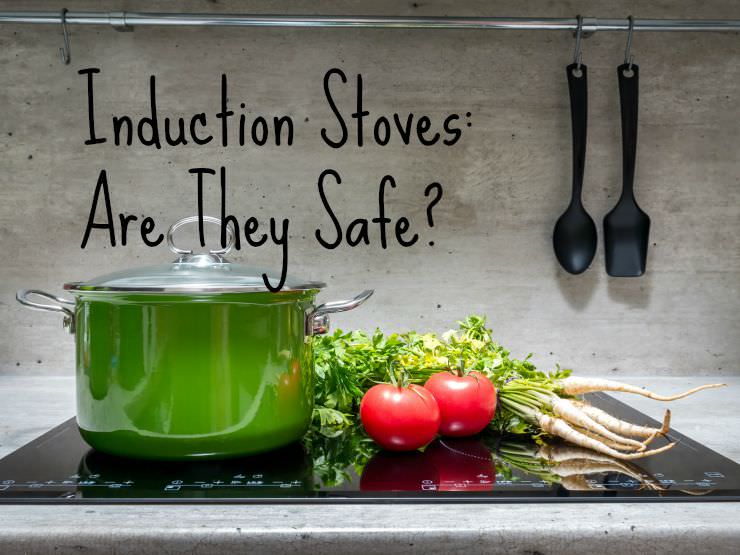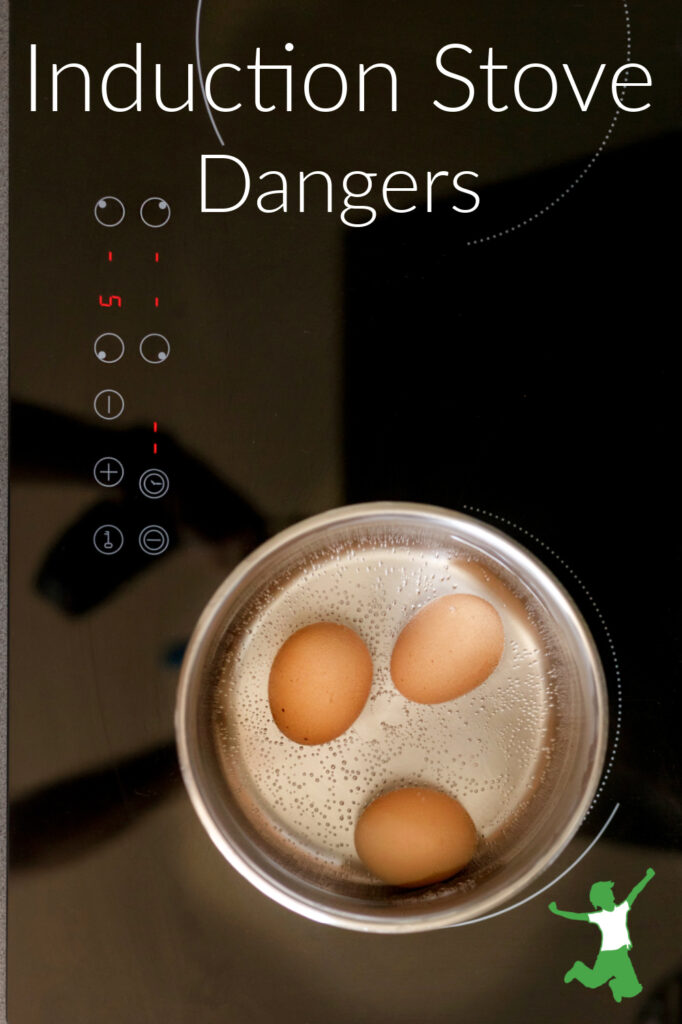The important reasons why bringing an induction stove into your home should be approached with caution as this technology is a source of excessive EMF toxicity as confirmed by scientific study. Even induction stove user manuals warn against standing too close!

Buying a kitchen stove is a rare purchase most people make only a few times in a lifetime. Currently, the trend toward replacing electric cooktops with an induction stove is quite popular. Is this a wise purchase? Let’s take a look …
In our home, we purchased a glass top stove in 1997 when we completely remodeled the (very old) kitchen. At that time, the range we selected boasted the latest and greatest technology which included a glass top cooking surface.
We were upgrading from a tiny 1950’s stove (see hilarious picture below) that while it seemed to fit very well with the orange, 1970s style wallpaper, fake butcher block countertops and canary yellow cabinets (no kidding), it was not something we regretted replacing!
While this new range was awesome (so nice not to have to clean up messes under coil burners anymore!) and has served us well for many years, it recently came time to replace it when problems developed.
Induction, Gas or Electric?
Since we had upgraded to the best technology many years earlier with good results, we thought we should probably do so again. This involved the purchase of an induction stove with all the bells and whistles. The upgrade hopefully would make my many hours spent in the kitchen even more efficient.

Since indoor air-polluting gas stoves were thankfully not an option for our neighborhood, electric was our only choice. We made the rounds to Best Buy, Home Depot, and online to see what was available.
We eventually settled on a stainless steel induction stove. It offered nearly all the latest technology of the (amazing but ridiculously expensive) Viking stoves that celebrity chefs use but with a much more reasonable price tag.
This is the induction stove we originally picked that thankfully, we never bought (we bought this one instead).
I particularly liked the extra-large knobs and oversized glass top that prevented spills from trickling down the crack between the stove and the countertop. It was exactly what I was looking for.
We also decided to get the matching convection oven (that also functions as a toaster) to replace our old microwave oven that I only ever used for storage anyway.
Little Known Dangers of an Induction Stove
Really excited about our upcoming purchase, I posted about it on social media to see if anyone had any further input.
Right away, a couple of comments got my attention.
Jeanette K. said, “My mother’s induction stove was measured by EMF professionals and had extreme readings.”
In addition, Beth H. warned that “The only downfall [with an induction stove] is that you have to use pans that magnets can stick to”.
EMF Risks?
So glad I asked for the input! Neither of these concerns about induction stoves was mentioned by the salespeople I spoke to or the marketing material I had reviewed.
Since I frequently cook with glass, having to only use pans that magnets can stick to would be a serious downside.
It would require purchase of a few pieces of new cookware and bakeware which I really didn’t want or need.
But, it was Jeanette’s comment about the EMF dangers of an induction stove that really gave me pause. EMF overexposure is a huge concern of mine that I’ve written many articles about.
We take great pains in our home to minimize excessive EMF exposure such as turning off wifi at night, using radiation canceling cases and headsets for our cellphones, and EMF shields for our PCs and notebooks.
I also avoid dirty electricity in our home by never using dimmer switches, fluorescent, or LED bulbs.
In addition, we use battery power for our electronics as much as possible. Higher EMF exposure occurs when you use a laptop while it is plugged in, for example.
Induction Technology Emits Strong Magnetic Fields
When I started examining the technology behind an induction stove, I was more than a little shocked and incredibly grateful Jeanette had commented about it to clue me in to do further research. Here’s what I found out:
The technology of an induction stove works by alternating magnetic fields that generate heat in a cooking vessel made of ferrous metals. The benefits of induction cooking as opposed to thermal heating with a traditional stovetop include up to 50% faster and more even cooking of the food and slightly reduced energy usage.
Parents of young children like it because the coil itself underneath the glass stovetop doesn’t actually get hot. This means the cooking surface stays cool and won’t burn little hands or steam up if you spill liquid on it.
While it is extremely controversial whether this type of radiation source is actually dangerous, the data is sufficient enough for me to avoid it.
The latest information I found that should give anyone pause about bringing an induction stove into their home was published by the Journal Bioelectromagnetics in 2012. (1)
The study authors concluded that most induction hobs (rings) exceeded even the high 1998 maximum exposure levels set by the International Commission on Non-Ionizing Radiation Protection (ICNIRP) when a person was standing close to the induction stove.
The worst-case scenario was an up to 16-fold increase from these maximum exposure levels!
Safety Tests
So how in the world did induction stoves ever pass the safety tests?
According to Powerwatch, the safety tests assumed that a person’s body is never closer than 1 foot (30 cm) to the front of the induction stove. Standing that far away would be considered “normal usage”.
I don’t know about you, but I don’t cook standing at least a foot away from my stove. My arms definitely aren’t long enough!
In fact, this would be pretty much impossible if you needed to reach the back burners.
Don’t Use a Microwave? You Won’t Want Induction Either
The bottom line is that if you avoid microwaved food and microwaves in general, you will want to pass on the induction stove as it uses similar technology.
I’ve not used a microwave in 25 years (and not missed it for a second, I might add). Why would I start now exposing myself and my family to potentially dangerous, concentrated sources of EMFs with an induction stove which works in a similar fashion?
Of course, induction stove manufacturers insist the technology is safe.
They claim that the radiation hazard dissipates within a few inches to a foot of the appliance. “Normal usage” would not expose a person to a radiation hazard.
Right?
I’ll pass thanks.
Safer Alternatives
Fortunately, the exact same stove I wanted was available in a traditional, thermally based cooktop without an induction feature. This is the case with all the induction ranges I examined in fact!
This is the stainless steel electric stove model we eventually bought. We’ve had it for several years now and continue to love it! As a bonus, it much more easily fit within our budget than the unsafe induction models!
Sometimes the latest and greatest isn’t always the best or even the safest.

References
(1) Exposure of the human body to professional and domestic induction cooktops compared to the basic restrictions
(2) Powerwatch: In Your Home. EMF Cooking Safety
(3) Induction stove user manual
More Information
Are Pressure Cookers Safe (and do they form MSG in food?)
Clay Pots for Safe Cooking
10 Tips for Using Stainless Steel Cookware Safely
Fitbit Health Concerns (particularly while you sleep!)
Are AMR Devices Safer than Smart Meters?
Heavy Metal Toxicity Raises Risk of EMF Sensitivity
Reducing Exposure to Dirty Electricity
The Health Hazards of Wireless Baby Monitors
Harvard MD Speaks Out about the Health Dangers of Smart Meters
Protect Yourself from a Smart Meter








EMF in general are very, dangerous Mark. Specialy if you expose to them, there is facts in this article which every one should take to consideration before buying induction stove. Keep an eye you may have sellers of that product posting negative feedback ;). If you need more info. Google it.
I agreed with Mark’s comments. Using own opinion to judge is a common issue in social media nowadays. Hard fact is what we need to judge what is good and bad. The paper you mentioned have so much information you haven’t post here. talking about how bad it is, may be you can share a bit more info than just distance, like how long, age, and consequence.
I am not trying to criticize your article’s details, but writer has a duty to give facts to reader and not just believe.
Hi Sarah good article. Been wondering about this myself as I’ve been doing such much emf research. My boyfriend is a Saladmaster dealer-not sure if you heard of them but a fantasitic cookware if you’re in the market. Anyways Saladmaster being titanium/stainless steel cooks well on induction stoves and we happen to have a portable one at home that we were using often. So it isn’t a countertop induction stove but a portable one and now my boyfriend wants to know if the portable emits as many or as much emfs as the stove top. I’m trying to find actual data on that because he’s kind of upset to hear this. Thanks!
I stayed at my boyfriend’s home for 5 weeks. he has an induction oven and every time I cook, i feel dizzy. Only if I use two or three pots and for a long time. It is usually fine for short time cooking like frying eggs and such.
Today I made dinner which took much longer to prepare than normal and i felt very nauseous. My boyfriend even noticed it. It doesn’t affect him the same, but he cooks more simpler food.
Think it’s stand 12 inches away from the element you are using to cook with not the front of the stove. The back elements are physically farther away from you therefore the EMF would be less to nil compared to the front.
Well then please do enjoy all that lovely carbon monoxide from burning all that gas.
These types of articles are all about scaremongering, almost everything in life carries risks you shouldn’t change your mind because of one overly simplified article, this is a blog post not a peer-reviewed scientific paper.
Think for yourselves, do your own research (its never been easier), make your own decisions based on as many sources as possible.
Where did you get the idea that this article suggested that all electrical stoves were bad and gas stoves were best? Looks like you read the title and knee jerk commented perhaps?
Note that the manufacturers of induction stoves themselves WARN against standing too close to them as it is dangerous to health. The length of my arms is not conducive to standing at least 1 foot away from a cooktop, so this type of stove isn’t for me. Good old fashioned electric will do just fine.
Hi Sarah interesting article and amazing the manufacturers can still sell these products.I was seriously contemplating updating my stove to induction but will get a gas oven and cooktop instead which I have had for years.
Thanks for the information – I would also question how it effects the food – as I have heard so many negative comments on how scientific research have found so many toxic effects of microwaved food.
If there is any danger, it’s probably so low that it would be within the margin of error but this is very dependent on exposure time and power setting. Standing right next to the induction surface for hours at a time while setting it to the highest power levels might not be the safest thing to do, a warning about pacemakers in the manual of my model means there is sufficient EMF for potential electronic disruptions. The technology is extremely practical and energy saving compared to alternatives since the surface does not heat up, cooking during summer is much more pleasant with such a device. Also, my version has a temperature setting and a timer which basically makes quite a few processes automatic. In these cases there’s no need to be right next to the device. All in all, if used properly, there shouldn’t be any cancer risk. There are far greater risks from transportation exhausts and other pollution that is all around us on a daily basis.
If you put your hand in a microwave oven, your hand will explode. If you put your hand on an induction hob you will not feel anything. So, Sarah, please: don’t compare microwaves oven with induction stoves! They are very different. One is a killing machine, the other is not. Also read this conclusion of a scientific study:
„Kos and his colleagues measured the magnetic flux density (B) at 30 cm from the front of the induction cooker, as well as at distances of 1, 5 and 10 cm. Measurements were also taken at various vertical distances relative to the level of the cooking surface, which was 85 cm from the ground. All of these data were then applied to a numerical model in order to calculate the induced electric field (E) and induced current (J) in 26- and 30-week pregnant women, and 6- and 11- year old children.
In all cases, the calculated values of E and J fell BELLOW the basic restrictions published in the guidelines, as one would expect from any electrical appliance on the market. However, the team found that the pot size used with respect to the size of the cooking area had a strong effect on the stray magnetic fields. Placing pots with diameters of 15, 20 and 25 cm on the same 21 cm cooking ring resulted in magnetic fields of 4.5, 2.4 and 0.9 µT respectively – a significant variation”